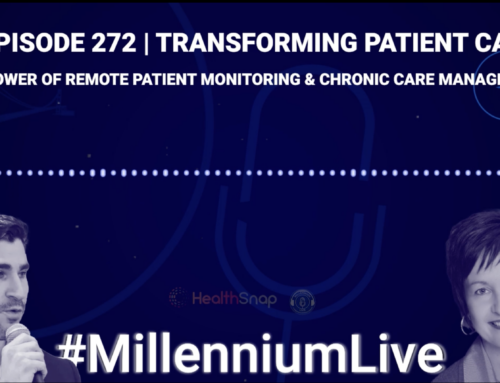By Wesley Smith, Ph.D., HealthSnap Co-Founder & Chief Scientific Officer
In the battle against chronic conditions, a Chronic Care Management (CCM) program featuring an evidence-based, integrative care plan can be a vital strategy to save and improve lives. This strategy proves especially effective as numerous chronic conditions, although treated individually from a clinical perspective, have shared origins and mechanisms linked to lifestyle factors. A perfect illustration of this interconnectedness can start with the example of inactivity and poor diet.
The Ripple Effect of Inactivity and Poor Diet
Carbohydrates primarily serve one function – providing energy. This means the more active you are, the more carbohydrates you need. Such a principle highlights why combining a sedentary lifestyle with a diet rich in processed foods and carbohydrates can be detrimental. The negative impacts of this combination start with the critical issue of glycogen becoming “trapped” in muscle tissues. When muscles are saturated with glycogen, the storage form of glucose, due to a lack of physical activity, it sets the stage for significant metabolic health issues. This saturation triggers a cascade of reactions that disrupt normal glucose metabolism and insulin signaling. Given that glycogen in the muscles cannot be broken down into glucose and released into the bloodstream as in the liver (they do not have the liver’s phosphatase enzymes) the only method to utilize this stored glycogen is through muscle contraction or regular movement. Consequently, without physical activity, these glycogen reserves remain untapped, leading to a sort of “glycogen saturation.” Essentially, the muscles’ capacity to store more glucose is diminished, which begins to impede insulin’s action on the muscle cells (insulin resistance).
The excessive accumulation of glycogen inhibits the activity of glycogen synthase, the enzyme responsible for converting glucose into glycogen, upon the presence of insulin. Normally, insulin would facilitate this conversion, promoting the storage of glucose as glycogen. However, when glycogen stores are full, further activation of this enzyme is blocked, leading to disruptions in the insulin signaling pathway. Specifically, it affects the translocation of GLUT4 receptors to the cell membrane, a crucial step needed for glucose to enter the cells from the bloodstream, thereby contributing to insulin resistance.

As a consequence of this impaired insulin signaling, blood glucose levels remain elevated, which is severely damaging to the body. Therefore, the pancreas is triggered to release more insulin into the bloodstream, a condition known as hyperinsulinemia. While initially serving as a compensatory mechanism to lower blood glucose levels, chronic hyperinsulinemia exacerbates metabolic disruptions. It significantly influences fatty acid metabolism in the liver, promoting the synthesis of fatty acids and inhibiting fat oxidation in favor of carbohydrate metabolism. This occurs because the primary site for storing glucose, the muscle, is maxed out, so the body resorts to storing the excess glucose as fat. Additionally, to help rid the body of the dangerous glucose accumulation, insulin influences the body to burn glucose rather than fat. This metabolic shift not only reduces the body’s ability to use fats as an energy source but may also lead to the accumulation of lipids in non-adipose tissues, exacerbating insulin resistance and increasing the risk of further complications.

The context of insulin resistance and hyperinsulinemia highlights the profound effects of inactivity and poor diet on metabolic health. To mitigate glycogen saturation and restore insulin sensitivity, regular physical activity is paramount. Exercise facilitates muscle contractions that help use stored glycogen and improve the efficiency of the insulin signaling pathway, enhancing glucose uptake and fueling active muscle cells, to restore a more healthy metabolic balance.
The Path to Hypertension and Heart Failure
Hyperinsulinemia also has a noteworthy impact on blood volume and pressure through its effects on renal sodium retention and its interactions with aldosterone, a hormone that increases blood volume. This fluid overload can precipitate hypertension and elevate the risk of heart failure, illustrating how dietary and lifestyle choices can spiral into severe health issues. Insulin’s multifaceted influence extends to various physiological systems, including the kidneys, where it plays a significant role in managing blood volume and pressure.

Insulin’s Role in Sodium Reabsorption and Blood Volume Regulation
-
Sodium Reabsorption: One of insulin’s functions is to increase sodium reabsorption in the renal tubules of the kidneys. This action ensures that less sodium is lost through urine, contributing to sodium retention in the body. Given sodium’s crucial role in controlling blood volume, its retention naturally leads to water retention, thereby increasing blood volume. This increase may be intended to dilute blood glucose, which insulin is tasked with managing. This process can have direct implications for blood pressure, as increased blood volume puts additional strain on the walls of blood vessels.
-
Synergistic Hormonal Effects: Insulin does not operate in isolation. Its effects on sodium and water retention are intricately linked with the actions of other hormones, notably aldosterone. Aldosterone’s primary role is to regulate sodium and potassium levels, but when coupled with insulin’s actions, these hormonal interactions can intensify sodium retention and water reabsorption, further impacting blood volume and elevating blood pressure.
-
Influence on Blood Vessels: Beyond its direct actions on the kidneys, insulin also exerts vasodilatory effects, which increase blood flow to various organs, including the kidneys themselves. This heightened blood flow can modify the kidney’s filtration and reabsorption capacities, indirectly influencing how blood volume is regulated. An increase in blood flow might alter the dynamics of sodium reabsorption and, by extension, affect fluid balance within the body.
-
Overall Impact on Fluid Balance: Through its promotion of sodium reabsorption and potential adjustments in the balance of other ions and water, insulin is integral to the body’s fluid balance mechanism. Disruptions in insulin regulation, as seen in diabetes mellitus, can lead to imbalances that affect both fluid balance and blood volume. These imbalances underscore the critical role of insulin in maintaining not just glucose homeostasis but also in managing blood pressure and volume.
The intricate connections between insulin action, renal function, and cardiovascular health paint a comprehensive picture of how hyperinsulinemia can contribute to the development of hypertension and heart failure. It underscores the importance of considering the systemic effects of insulin beyond its traditional role in glucose metabolism, highlighting the need for integrated approaches in managing conditions that involve insulin resistance. Recognizing these interconnected mechanisms emphasizes the significance of lifestyle interventions that can mitigate the adverse effects of hyperinsulinemia on the body’s circulatory and renal systems.
Restoring Balance Through Lifestyle Interventions
Addressing this complex web of metabolic dysregulation requires more than medication alone. Exercise plays a crucial role in reducing glycogen stores, thereby restoring insulin sensitivity. Coupled with a whole food, lower glycemic diet, these lifestyle adjustments attack the root mechanism of the metabolic disease cluster. Beyond these basic principles, understanding the nuances of exercise’s impact on the body further elucidates its critical role in combating metabolic imbalances.
The Importance of Regular Physical Activity

Regular physical activity is paramount in utilizing muscle glycogen and maintaining muscle sensitivity to insulin, which, in turn, enhances fat metabolism. The type of exercise performed can influence the rate and manner in which glycogen stores are depleted and how insulin sensitivity is improved.
-
High Volume, Low-Intensity Exercise: Engaging in long-duration, low-intensity exercise primarily targets the slow-twitch muscle fibers, which are known for their endurance capabilities. This form of exercise aids in additional glycogen depletion from these fibers and improves fat metabolism. It is especially effective for those looking to manage or reduce body fat levels while also enhancing insulin sensitivity.
-
High-Intensity Interval Training (HIIT): On the other end of the spectrum, high-intensity interval training puts an emphasis on glycolytic (fast-twitch) muscle fibers, which have a higher glycogen capacity. HIIT is crucial for rapidly depleting glycogen stores in these fibers, thereby playing a significant role in improving insulin action. The vigorous nature of HIIT also stimulates various adaptations within the body that can contribute to enhanced glucose regulation and metabolic health.
For individuals who are able and willing to engage in diverse forms of exercise, incorporating both long, slow endurance activities and high-intensity interval training into their routines offers a comprehensive approach to managing insulin sensitivity and overall metabolic health.
The Role of Resistance Training

Resistance training occupies a unique position in the pantheon of exercise modalities, particularly for its ability to increase or at least help maintain muscle mass. Muscle tissue acts as the primary storage site for glucose (in the form of glycogen), making it a critical player in the protection against glucose damage and metabolic dysfunction. By increasing muscle mass through resistance training, the physiological cross-sectional area available for glucose storage expands. This enhancement in glucose storage capacity not only aids in the immediate utilization of blood glucose but also contributes to the long-term prevention and reversal of metabolic diseases.
The Chronic Care Management (CCM) Program: A New Age of Treatment

A CCM program that emphasizes patient compliance with medication, alongside monitoring of blood pressure, blood sugar, and body weight, forms the backbone of an effective treatment plan for chronic conditions. However, another essential, unique strength lies in integrating lifestyle interventions focused on physical activity, diet, stress management, and sleep. This holistic approach ensures that treatment is not just about managing symptoms but addressing the underlying causes of chronic conditions.
A critical enhancement to this approach is the incorporation of a remote care navigator, a trained professional equipped to perform occasional remote check-ins with patients. This role is pivotal in ensuring patients adhere to their care plans, identifying new symptoms or issues that need to be communicated to the provider, ensuring medication reconciliation, and reviewing remote physiological data from monitoring devices. The remote care navigator acts as a guide on the side of the patient, providing a supportive and informative presence that empowers patients to take an active role in managing their health.
This added layer of support helps foster self-efficacy among patients, giving them the confidence and tools to gain control over their condition, even if progress feels incremental at times. The relationship between a patient and their remote care navigator is built on trust and regular communication, creating a dynamic where patients feel supported and understood. By focusing on the patient’s ability to manage their health effectively, the CCM program not only addresses the immediate needs related to chronic conditions but also contributes to long-term health improvements. The inclusion of remote care navigators in the CCM program exemplifies a patient-centered approach that recognizes the importance of empowering individuals in their health journeys, ultimately leading to better health outcomes and an improved quality of life.
Conclusion
Chronic conditions present a complex challenge, often intertwined and exacerbated by lifestyle factors. A CCM program, with its comprehensive care plan, stands as an ideal solution by not only tackling the symptoms with medication and monitoring but also addressing the lifestyle factors at the heart of these conditions. By incorporating exercise and dietary changes to restore insulin sensitivity and manage weight, combined with strategies for stress management and sleep, the CCM program represents a holistic, new-age form of treatment tailored to combat chronic diseases effectively.
This multifaceted approach underscores the importance of considering the whole patient lifestyle, environment, and medical history in the treatment plan, paving the way for more sustainable health outcomes and a better quality of life for those battling chronic conditions.
Furthermore, the integration of CCM and RPM technologies into the care plan enables these services to be provided to patients regardless of their zip code. This approach plays a crucial role in bridging the gaps in healthcare access and equity that persist across different regions. By using digital tools and platforms, CCM and RPM ensure that geographical location does not hinder a patient’s ability to receive high-quality, consistent care. Whether a patient lives in a densely populated urban area or a remote rural location, they can have equal access to the health monitoring, guidance, and support needed to manage their condition effectively.
This equal access initiative is particularly significant in addressing disparities in healthcare delivery and outcomes, making it possible for all patients, irrespective of where they live, to benefit from a personalized and proactive healthcare strategy. It democratizes health care, offering a viable solution to overcome traditional barriers to accessing care services and thereby contributing to the broader goals of healthcare access and equity. Through this innovative approach, the CCM program not only addresses the immediate needs related to managing chronic conditions but also contributes to leveling the playing field in healthcare provision, ensuring that every patient has the opportunity to achieve optimal health outcomes.













Leave A Comment
You must be logged in to post a comment.